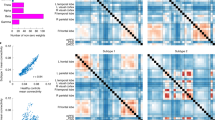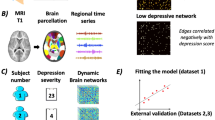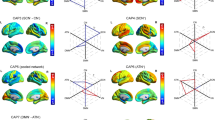Abstract
This study aims to identify dynamic patterns within the spatiotemporal feature space that are specific to nonpsychotic major depression (NPMD), psychotic major depression (PMD), and schizophrenia (SCZ). The study also evaluates the effectiveness of machine learning algorithms based on these network manifestations in differentiating individuals with NPMD, PMD, and SCZ. A total of 579 participants were recruited, including 152 patients with NPMD, 45 patients with PMD, 185 patients with SCZ, and 197 healthy controls (HCs). A dynamic functional connectivity (DFC) approach was employed to estimate the principal FC states within each diagnostic group. Incremental proportions of data (ranging from 10% to 100%) within each diagnostic group were used for variability testing. DFC metrics, such as proportion, mean duration, and transition number, were examined among the four diagnostic groups to identify disease-related neural activity patterns. These patterns were then used to train a two-layer classifier for the four groups (HC, NPMD, PMD, and SCZ). The four principal brain states (i.e., states 1,2,3, and 4) identified by the DFC approach were highly representative within and across diagnostic groups. Between-group comparisons revealed significant differences in network metrics of state 2 and state 3, within delta, theta, and gamma frequency bands, between healthy individuals and patients in each diagnostic group (p < 0.01, FDR corrected). Moreover, the identified key dynamic network metrics achieved an accuracy of 73.1 ± 2.8% in the four-way classification of HC, NPMD, PMD, and SCZ, outperforming the static functional connectivity (SFC) approach (p < 0.001). These findings suggest that the proposed DFC approach can identify dynamic network biomarkers at the single-subject level. These biomarkers have the potential to accurately differentiate individual subjects among various diagnostic groups of psychiatric disorders or healthy controls. This work may contribute to the development of a valuable EEG-based diagnostic tool with enhanced accuracy and assistive capabilities.
This is a preview of subscription content, access via your institution
Access options
Subscribe to this journal
Receive 12 print issues and online access
$259.00 per year
only $21.58 per issue
Buy this article
- Purchase on Springer Link
- Instant access to full article PDF
Prices may be subject to local taxes which are calculated during checkout





Similar content being viewed by others
Data availability
The data that support the findings of this study are available from the corresponding author upon reasonable request.
References
Collaborators GMD. Global, regional, and national burden of 12 mental disorders in 204 countries and territories, 1990-2019: a systematic analysis for the Global Burden of Disease Study 2019. Lancet Psychiatry. 2022;9:137–50.
Moitra M, Santomauro D, Collins PY, Vos T, Whiteford H, Saxena S, et al. The global gap in treatment coverage for major depressive disorder in 84 countries from 2000-2019: A systematic review and Bayesian meta-regression analysis. PLoS Med. 2022;19:e1003901.
Malhi GS, Mann JJ. Depression. Lancet. 2018;392:2299–312.
Dubovsky SL, Ghosh BM, Serotte JC, Cranwell V. Psychotic depression: diagnosis, differential diagnosis, and treatment. Psychother Psychosom. 2021;90:160–77.
Paljärvi T, Tiihonen J, Lähteenvuo M, Tanskanen A, Fazel S, Taipale H. Mortality in psychotic depression: 18-year follow-up study. Br J Psychiatry. 2023;222:37–43.
Jauhar S, Johnstone M, McKenna PJ. Schizophrenia. Lancet. 2022;399:473–86.
Kalin NH. Depression and schizophrenia: sleep, medical risk factors, biomarkers, and treatment. Am J Psychiatry. 2021;178:881–4.
Rosen C, Harrow M, Tong L, Jobe TH, Harrow H. A word is worth a thousand pictures: A 20-year comparative analysis of aberrant abstraction in schizophrenia, affective psychosis, and non-psychotic depression. Schizophr Res. 2021;238:1–9.
Li X, Zhang X, Zhu J, Mao W, Sun S, Wang Z, et al. Depression recognition using machine learning methods with different feature generation strategies. Artif Intell Med. 2019;99:101696.
Hawco C, Buchanan RW, Calarco N, Mulsant BH, Viviano JD, Dickie EW, et al. Separable and replicable neural strategies during social brain function in people with and without severe mental illness. Am J Psychiatry. 2019;176:521–30.
Chen J, Patil KR, Yeo BTT, Eickhoff SB. Leveraging machine learning for gaining neurobiological and nosological insights in psychiatric research. Biol Psychiatry. 2023;93:18–28.
Sen B, Cullen KR, Parhi KK. Classification of adolescent major depressive disorder via static and dynamic connectivity. IEEE J Biomed Health Inf. 2021;25:2604–14.
Chao J, Zheng S, Wu H, Wang D, Zhang X, Peng H, et al. fNIRS evidence for distinguishing patients with major depression and healthy controls. IEEE Trans Neural Syst Rehabil Eng. 2021;29:2211–21.
Zhang B, Yan G, Yang Z, Su Y, Wang J, Lei T. Brain functional networks based on resting-state EEG data for major depressive disorder analysis and classification. IEEE Trans Neural Syst Rehabil Eng. 2021;29:215–29.
da Cruz JR, Favrod O, Roinishvili M, Chkonia E, Brand A, Mohr C, et al. EEG microstates are a candidate endophenotype for schizophrenia. Nat Commun. 2020;11:3089.
Li R, Li S, Roh J, Wang C, Zhang Y. Multimodal neuroimaging using concurrent EEG/fNIRS for poststroke recovery assessment: an exploratory study. Neurorehabil Neural Repair. 2020;34:1099–110.
Jiao B, Li R, Zhou H, Qing K, Liu H, Pan H, et al. Neural biomarker diagnosis and prediction to mild cognitive impairment and Alzheimer’s disease using EEG technology. Alzheimers Res Ther. 2023;15:32.
Li R, Nguyen T, Potter T, Zhang Y. Dynamic cortical connectivity alterations associated with Alzheimer’s disease: An EEG and fNIRS integration study. Neuroimage Clin. 2019;21:101622.
De Aguiar Neto FS, Rosa JLG. Depression biomarkers using non-invasive EEG: A review. Neurosci Biobehav Rev. 2019;105:83–93.
Zhang X, Shen J, Din ZU, Liu J, Wang G, Hu B. Multimodal depression detection: fusion of electroencephalography and paralinguistic behaviors using a novel strategy for classifier ensemble. IEEE J Biomed Health Inform. 2019;23:2265–75.
Jang KI, Kim S, Kim SY, Lee C, Chae JH. Machine learning-based electroencephalographic phenotypes of schizophrenia and major depressive disorder. Front Psychiatry. 2021;12:745458.
Jang KI, Lee C, Lee S, Huh S, Chae JH. Comparison of frontal alpha asymmetry among schizophrenia patients, major depressive disorder patients, and healthy controls. BMC Psychiatry. 2020;20:586.
Cao J, Zhao Y, Shan X, Wei HL, Guo Y, Chen L, et al. Brain functional and effective connectivity based on electroencephalography recordings: A review. Hum Brain Mapp. 2022;43:860–79.
Bullmore ET, Fornito A. Making connections: biological mechanisms of human brain (Dys)connectivity. Biol Psychiatry. 2023;93:384–5.
Briels CT, Schoonhoven DN, Stam CJ, de Waal H, Scheltens P, Gouw AA. Reproducibility of EEG functional connectivity in Alzheimer’s disease. Alzheimers Res Ther. 2020;12:68.
Hallett M, de Haan W, Deco G, Dengler R, Di Iorio R, Gallea C, et al. Human brain connectivity: Clinical applications for clinical neurophysiology. Clin Neurophysiol. 2020;131:1621–51.
Tinaz S. Functional connectome in Parkinson’s disease and Parkinsonism. Curr Neurol Neurosci Rep. 2021;21:24.
Shim M, Im CH, Kim YW, Lee SH. Altered cortical functional network in major depressive disorder: A resting-state electroencephalogram study. Neuroimage Clin. 2018;19:1000–7.
Yun JY, Kim YK. Graph theory approach for the structural-functional brain connectome of depression. Prog Neuropsychopharmacol Biol Psychiatry. 2021;111:110401.
Xia CH, Ma Z, Ciric R, Gu S, Betzel RF, Kaczkurkin AN, et al. Linked dimensions of psychopathology and connectivity in functional brain networks. Nat Commun. 2018;9:3003.
Pervaiz U, Vidaurre D, Gohil C, Smith SM, Woolrich MW. Multi-dynamic modelling reveals strongly time-varying resting fMRI correlations. Med Image Anal. 2022;77:102366.
Peng X, Liu Q, Hubbard CS, Wang D, Zhu W, Fox MD, et al. Robust dynamic brain coactivation states estimated in individuals. Sci Adv. 2023;9:eabq8566.
Li R, Mayseless N, Balters S, Reiss AL. Dynamic inter-brain synchrony in real-life inter-personal cooperation: A functional near-infrared spectroscopy hyperscanning study. Neuroimage. 2021;238:118263.
Zhang J, Cheng W, Liu Z, Zhang K, Lei X, Yao Y, et al. Neural, electrophysiological and anatomical basis of brain-network variability and its characteristic changes in mental disorders. Brain. 2016;139:2307–21.
Kim J, Criaud M, Cho SS, Díez-Cirarda M, Mihaescu A, Coakeley S, et al. Abnormal intrinsic brain functional network dynamics in Parkinson’s disease. Brain. 2017;140:2955–67.
Du Y, Pearlson GD, Yu Q, He H, Lin D, Sui J, et al. Interaction among subsystems within default mode network diminished in schizophrenia patients: A dynamic connectivity approach. Schizophr Res. 2016;170:55–65.
Liu F, Wang Y, Li M, Wang W, Li R, Zhang Z, et al. Dynamic functional network connectivity in idiopathic generalized epilepsy with generalized tonic-clonic seizure. Hum Brain Mapp. 2017;38:957–73.
Damaraju E, Allen EA, Belger A, Ford JM, McEwen S, Mathalon DH, et al. Dynamic functional connectivity analysis reveals transient states of dysconnectivity in schizophrenia. Neuroimage Clin. 2014;5:298–308.
Rashid B, Arbabshirani MR, Damaraju E, Cetin MS, Miller R, Pearlson GD, et al. Classification of schizophrenia and bipolar patients using static and dynamic resting-state fMRI brain connectivity. Neuroimage. 2016;134:645–57.
Kallionpää RE, Valli K, Scheinin A, Långsjö J, Maksimow A, Vahlberg T, et al. Alpha band frontal connectivity is a state-specific electroencephalographic correlate of unresponsiveness during exposure to dexmedetomidine and propofol. Br J Anaesth. 2020;125:518–28.
Mahmoudian M, Venäläinen MS, Klén R, Elo LL. Stable iterative variable selection. Bioinformatics. 2021;37:4810–7.
Dunne AL. Psychopathy and the Diagnostic and Statistical Manual of Mental Disorders Fifth Edition alternative model of personality disorder: a synthesis and critique of the emergent literature. Curr Opin Psychiatry. 2021;34:64–69.
Whiting D, Lichtenstein P, Fazel S. Violence and mental disorders: a structured review of associations by individual diagnoses, risk factors, and risk assessment. Lancet Psychiatry. 2021;8:150–61.
Hutchison RM, Womelsdorf T, Allen EA, Bandettini PA, Calhoun VD, Corbetta M, et al. Dynamic functional connectivity: promise, issues, and interpretations. Neuroimage. 2013;80:360–78.
Kaiser RH, Andrews-Hanna JR, Wager TD, Pizzagalli DA. Large-scale network dysfunction in major depressive disorder: a meta-analysis of resting-state functional connectivity. JAMA Psychiatry. 2015;72:603–11.
Benschop L, Poppa T, Medani T, Shahabi H, Baeken C, Leahy RM, et al. Electrophysiological scarring in remitted depressed patients: Elevated EEG functional connectivity between the posterior cingulate cortex and the subgenual prefrontal cortex as a neural marker for rumination. J Affect Disord. 2021;281:493–501.
Lebois LAM, Li M, Baker JT, Wolff JD, Wang D, Lambros AM, et al. Large-scale functional brain network architecture changes associated with trauma-related dissociation. Am J Psychiatry. 2021;178:165–73.
Mantini D, Perrucci MG, Del Gratta C, Romani GL, Corbetta M. Electrophysiological signatures of resting state networks in the human brain. Proc Natl Acad Sci USA. 2007;104:13170–5.
Akar SA, Kara S, Agambayev S, Bilgic V. Nonlinear analysis of EEG in major depression with fractal dimensions. Annu Int Conf IEEE Eng Med Biol Soc. 2015;2015:7410–3.
Dienel SJ, Lewis DA. Alterations in cortical interneurons and cognitive function in schizophrenia. Neurobiol Dis. 2019;131:104208.
Acknowledgements
The authors are grateful to the participants for contributing to this research.
Funding
This work was supported by the National Natural Science Foundation of China (82071543, 82171509), the Key Research and Development Program of Hunan Province (2023SK2028), the Key Guiding Project of Hunan Health Committee (202103091470), STI2030-Major Projects-2021ZD0200700 and the Fundamental Research Funds for the Central Universities of Central South University (2022ZZTS0858).
Author information
Authors and Affiliations
Contributions
HC, YL and JZ conceived and designed the study. XC, JL, HT, YT, YG and JZ participated in the acquisition of data. YL, XX, and NC analyzed the data. HC and YL drafted the manuscript, RL, NC, JZ and XW revised the manuscript. All authors read and approved the final manuscript.
Corresponding authors
Ethics declarations
Competing interests
Yanqin Lei, Xinxin Xia, and Nanyi Cui report salary from TeleBrain Medical Technology. The authors declare no conflict of interest. All the funding sources listed had no role in study design; in the collection, analysis, and interpretation of data; in the writing of the report; and in the decision to submit the paper for publication.
Additional information
Publisher’s note Springer Nature remains neutral with regard to jurisdictional claims in published maps and institutional affiliations.
Supplementary information
Rights and permissions
Springer Nature or its licensor (e.g. a society or other partner) holds exclusive rights to this article under a publishing agreement with the author(s) or other rightsholder(s); author self-archiving of the accepted manuscript version of this article is solely governed by the terms of such publishing agreement and applicable law.
About this article
Cite this article
Chen, H., Lei, Y., Li, R. et al. Resting-state EEG dynamic functional connectivity distinguishes non-psychotic major depression, psychotic major depression and schizophrenia. Mol Psychiatry (2024). https://doi.org/10.1038/s41380-023-02395-3
Received:
Revised:
Accepted:
Published:
DOI: https://doi.org/10.1038/s41380-023-02395-3



